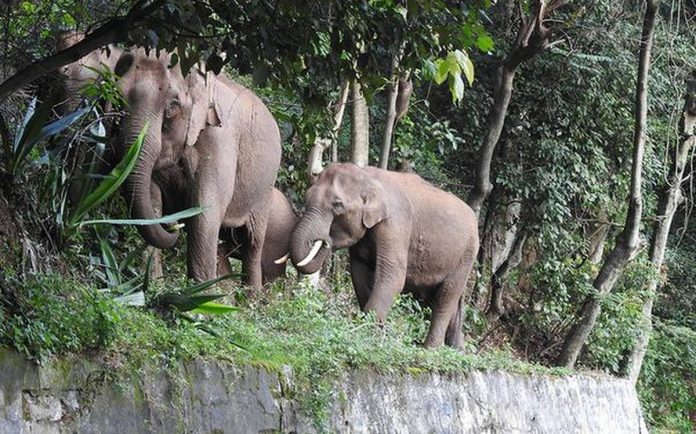This article has been written by Sonia Shrinivasan.
Table of Contents
Introduction
Indian history bears testimony to the importance animals hold in our age-old customs and beliefs. From being considered as vehicles of deities in certain cultures to worshipping them as gods themselves, we consider it our sacrosanct duty to nurture and protect these creatures.
The Asian Elephant, also known as the Asiatic Elephants by many, is known to be the only surviving species of the Elephas genus, centered in and around the Indian Subcontinent and Southeast Asia. The largest living animal on land in the Asian continent is culturally revered all across and yet sadly finds itself enlisted as an endangered species in the International Union for Conservation of Nature’s Red List of Endangered Species, popularly known as the Red Data Book, since 1968.
These figures indicate that despite being traditionally revered all across and being given very strict protection under the wildlife protection laws operating in the country, the species is prone to a lot of challenges in the country. The root cause of this, like for all environmental imbalances in the country, is the unavailability of land, thanks to the population explosion in recent years, resulting in a rapid expansion of human dwellings for building roads, houses, dams, growing crops, etc. This directly impacts the forest cover rather negatively, thereby endangering their habitats.
Project Elephant
According to the 2017 census, their population in the wild was estimated to be around 27,312 individuals; India single-handedly accounting for almost 55 per cent of their global population. Predominantly found in 29 elephant reserves, known to be spread over 10 states, covering almost 65,814 square kilometres of forests throughout the country.
To ensure the welfare and survival of the Asian Elephant species, the Ministry of Environment Forests and Climate Change in 1992 launched a nationwide program- Project Elephant, majorly focusing on elephant frequented states- i.e., West Bengal, Uttar Pradesh, Tripura, Uttarakhand, Tamil Nadu, Odisha, Nagaland, Meghalaya, Maharashtra, Kerala, Karnataka, Jharkhand, Chhattisgarh, Assam, Arunachal Pradesh, and Andhra Pradesh; aiming at ensuring the protection of the natural habitats, migration corridors, etc. in order for the long-term survival in the country. Essentially, it is a centrally sponsored scheme launched with the objective to minimize human-animal conflict, save these animals from being poached, hunted, and dying unnatural deaths, restorative of their natural habitats and migratory routes; along with ensuring the welfare of captive elephants and building and establishing rehabilitation and rescue shelters for them.
Due to this project, the entire concept of developing and maintaining ‘Elephant Corridors’ was given the central government’s nod and has yielded great results in furthering the aims and objectives of this ambitious project.
Elephant Corridors
Elephants, being huge animals that move in large herds, are dependent on vegetation in the wild to meet their food intake and hence require vast areas of land to move freely in search of water and food. Environmentalists believe that the home range of an average-sized elephant herd can vary from as small as 250-meter squares (as seen in Rajaji National Park) to 3500-meter squares (as observed in the state of West Bengal). The figures give an impression of vast territorial lands, but more often than not, include human settlements in some form or another, unless they lie under the reserved or protected forest areas. Hence, mostly, these elephant reserves are not legally protected habitats in themselves.
Also, it has been seen that increased and continuous degradation of forest land forces these large creatures to wander further away, in search of food and water, more often than not leading them into human dwellings, giving rise to man-animal conflicts.
The man-animal conflict involving elephants on one end of this balance is a cause of great concern, and rightly so. Their huge size- individually as well as collectively (their herds) has been known to cause damage worth millions to property and crops. This results in retaliatory actions by humans, mostly non-scientific methods like electrocution and poisoning in order to safeguard their holdings; inherently dangerous to elephants. Not to forget the killings done in order to obtain priceless ivory from these animals.
Even though most of the elephant population is concentrated in protected and reserved areas, there still exists a vast area of their habitat that is unprotected and highly prone to encroachment by humans. This is precisely why Elephant Corridors are needed. With rapid population growth, the forest cover stands the risk of being compromised in order to meet and provide for the needs of this growing population. By extension, the elephants are at the risk of losing their habitat.
As discussed earlier, the elephant population in India is majorly concentrated in protected national parks and forest areas in the North East, Central regions of India, along with the Himalayan Foothills and the Eastern and Western Ghats. The Indian climate can majorly be dubbed as being subtropical, with different parts of the country experiencing different levels of extremities in the summer, winter, and monsoon seasons. Therefore, in order to meet their food and fodder requirements all year round, the elephant herds are known to transmigrate between these protected forest areas through narrow passages of forests, connecting two major forestlands, known as ‘Elephant Corridors.’
Keeping all these points in mind, the Wildlife Trust of India (WTI) has been tirelessly working towards ensuring the elephants’ ‘right to passage’ within these narrow passages between major forestlands is legally protected in order to meet their food and water requirements perennially
The year 2005 saw WTI, in collaboration with its researchers, animal welfare groups, and NGOs identified 88 such corridors throughout the country in their detailed report- ‘Right of Passage: The Elephant Corridors of India.’
The WTI uses a self-evolved approach while determining, securing, and subsequently protecting these designated elephant corridors in the country and enlists four modes of acquisition of forestlands for this purpose- namely, the Private Purchase Model (the land is question is directly purchased and transferred to the concerned forest department for protection); the Community Securement Model (easements of collectively owned lands set aside); the Government Acquisition Model (the government formulates policies for acquiring the prime corridors and the needed technical assistance) and finally the Public Securement Model (a rather ambitious model, aiming towards creating a network comprising of local stakeholders, for monitoring of the corridors thus secured).
Among those corridors identified, the Thirunelli – Kudrakote (Kerala), Edayarhalli – Doddasampige (Karnataka), Kaniyanpura – Moyar (Karnataka), Siju – Rewak (Meghalaya) corridors stand secured, and several others in the states of Assam, Karnataka, etc. are in the process of being secured.
The Nilgiri Elephant Corridor
The Nilgiri Elephant corridor, also known as the Sigur Elephant Corridor, stands out of all those numerous corridors identified and is one of its kind. Its uniqueness is that it connects the Eastern Ghats with the ecologically fragile Western Ghats, helping in facilitating more than 6 thousand elephants from the states of Tamil Nadu, Kerala, and Karnataka. This particular corridor is the sole link between different habitats and is extremely crucial for maintaining a substantive elephant population in the region.
Upon execution, the corridor is said to connect the regions of Mudumalai, Nagarhole, Bandipur, Nilgiri North, Sathyamangalam forest areas in the three states, simultaneously being beneficial to other animal species like Asian king vultures, white striped hyenas, tigers, blackbucks, and four-horned antelopes; thereby bringing huge long-term benefits to flora and fauna of the Nilgiri Biosphere Reserve.
However, the identification of this corridor is said to potentially displace well over 12 thousand people and hundreds of families. A vast number of vacation homes and resorts falling in the designated corridor face closure, leading to loss of livelihood among the locals. This has earned stringent criticism by the local tribals and human rights activists for the lack of community forest management and endangering the idea of coexistence of man and nature.
The Nilgiri Elephant Corridor Case
The instances of conflicts between Elephants, based out of the Madumalai Tiger Reserve and owners of resorts in the neighbouring tourist spots, which usually result in the death of the former, highlight the fight over the land which is being reserved exclusively for the corridor, alleging displacement of thousands of people and the consequent loss of their livelihoods.
In 2006, the Tamil Nadu Chief Conservator of Forests proposed the acquisition of almost 202 acres of private land for the corridor, which was subsequently increased to 7000 acres of privately owned lands and revenue holdings. The owners of these landholdings were mostly tribals, Dalits, and Adivasis. This is when the locals started objecting to their potential displacement and began opposing this new, expanded corridor.
In 2008, many Animal Conservation Societies and NGOs approached the Madras High Court through a PIL, seeking removal of the encroached settlements in the corridor, and in 2011, the HC ordered the removal of all the settlements in the 7000-acre area, within three months of passing the order.
This decision of the Madras High Court was challenged before the Supreme Court in HOSPITALITY ASSOCIATION OF MUDUMALAI v IN DEFENCE OF ENVIRONMENT AND ANIMALS AND ORS. , Wherein the order of closure of as many as 821 constructions, including Resort Complexes, Houses, Public Utility (Water Tanks, Schools, Public Toilets, Temples, etc.), Estates, plantations,etc. were questioned on the grounds of it leading to the loss of livelihood for countless families and opposed the expansion of the said corridor. The hospitality association cited the loss of employment opportunities for the local tribals employed in these establishments, without which the crime rates may potentially increase.
In its judgment on the dispute in the matter in October 2020, a three-judge bench of the Supreme Court, comprising the then CJI SA Bobde along with Justices S Abdul Nazeer and Sanjeev Khanna, recognized their right to the passage and awarded them the status of a National Heritage Animal.
In its 44 page judgment, the Apex Court held that forests in the Sigur-Masinagudi region have shrunk and witnessed fragmentation due to the region’s various developmental activities and encroachment. This forces the elephants of the region to wander off into human-dominated regions, paving the way for man-animal conflicts.
The Supreme Court has directed the removal of all human establishments and settlements in the Sigur Elephant Corridor Area, sparing those of the tribals and traditional forest dwellers while enforcing the corridor. Further, a three-member committee has been constituted, consisting of K Venkatraman, Former Judge of the Madras High Court; Praveen Bhargava, Trustee of Wildlife First and Former Member of National Board for Wildlife; and conservationist Nandita Hazarika, in order to hear the grievances of the locals and determine the extent of compensation to be awarded to all those directly affected by the said order.
Conclusion
A lot has been said about how important elephants are to the wildlife diversity of the country. Many environmental conservationists opine that the seclusion of human beings from the elephant habitats and migratory routes will leave the elephant population thriving in their habitat, away from human encroachment and interference.
However, India boasts of community-inclusive practices when it comes to saving its flora and fauna, and the said exclusion of humans from the reserved corridor areas is a major setback for collective forest management. The Nilgiri Elephant Corridor is situated in close proximity to the Mudumalai Tiger Reserve in the state of Tamil Nadu, the Bandipur Tiger Reserve of Karnataka, and the scenic hill station of Ooty, attracting swarms of tourists annually. Hence, the Hospitality industry stands the worst affected by the ordered closure.
As is the case in most of the clashes between man and the environment, where human interests and environmental protection are in conflict with each other, recent judgments of the Supreme Court on the lines of the Mudumalai judgment, upholding the rights of these innocent creatures to their habitat can be considered to be a step in the right direction, prioritising wildlife conservation over the material aspects of economic development.
LawSikho has created a telegram group for exchanging legal knowledge, referrals, and various opportunities. You can click on this link and join:
 Serato DJ Crack 2025Serato DJ PRO Crack
Serato DJ Crack 2025Serato DJ PRO Crack











 Allow notifications
Allow notifications



